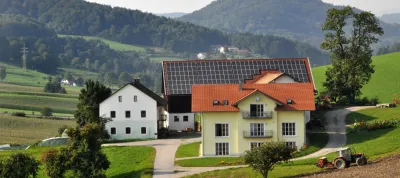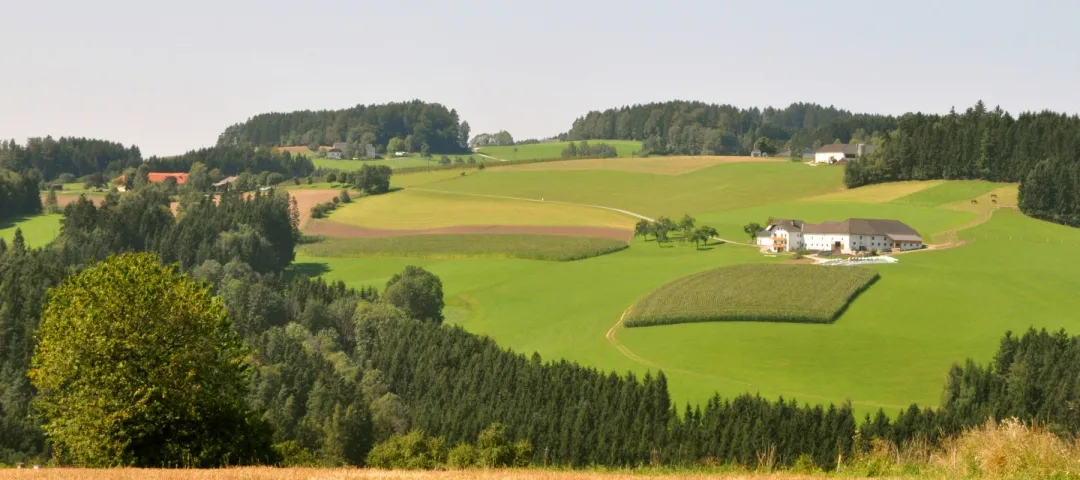General information
RDP Priority
- P1. Knowledge transfer and innovation
- P2. Competitiveness
- P3. Food chain and risk management
- P5. Resource efficiency and climate
RDP Focus Area
- 1A: Innovation & cooperation
- 2A: Farm’s performance, restructuring & modernisation
- 3A: Agri-food chain integration & quality
- 5D: Greenhouse gas & ammonia emissions
RDP Measure
- M16: Cooperation
Beneficiary type
- Operational group
Summary
In Austria, cattle and milk production account for a total of EUR 2 887 million, which is nearly 30% of the total production value of agriculture. Dairy farms are a significant stakeholder in the country’s climate action goals and the NEU.rind EIP-AGRI Operational Group (OG) project aimed to improve the sustainability of Austrian dairy and cattle farming. It developed a new digital farm management tool for assessing sustainability, efficiency and environmental impacts.
The user-friendly tool is available to many dairy farms. It provides key data and clear recommendations for action at individual farm level, e.g. reducing emissions or the demand for non-renewable resources.
Time savings result from the OG’s project, which allows the sustainability, efficiency and environmental impacts of a dairy farm to be assessed in two hours. This was achieved by linking and consolidating existing data, expert knowledge from the scientific partners, and cooperation between many different partners along the production chain.
Results
The OG actions resulted in an easy-to-use tool showing the sustainability, efficiency and environmental impacts of individual farms compared to others in Austria. Specifically, the NEU.rind project helped to:
- strengthen the competitiveness potential for approximately 23 000 dairy farms throughout Austria;
- provide farmers with a new digital toolkit for benchmarking, assessing sustainability, efficiency, and environmental impacts for farm-specific management;
- estimate potential improvement options from implementing farm-specific recommendations that enhance farm sustainability by reducing emissions or other environmental impacts;
- facilitate key figures that are easy to understand and can be generated for the individual farm;
- reduce by 88% (compared to the existing system) the working hours involved in assessing the sustainability, efficiency and environmental impact of a dairy farm.

Funding
Total budget 487 044 (EUR)
EAFRD: 226 522 (EUR)
National/Regional: 226 522 (EUR)
Private/own: 34 000 (EUR)
Themen
Keywords
Ressourcen
Documents
Links
Context
As European nations strive to meet climate targets set by international agreements, addressing the sustainability of dairy farming practices becomes more imperative. Transitioning towards more sustainable methods can mitigate these impacts while ensuring food security for a growing population.
Dairy farming in Europe can significantly contribute to GHG emissions, primarily through methane and nitrous oxide release. Methane (produced during digestion in cattle) is a potent GHG with a global warming potential greater than carbon dioxide. Additionally, the use of synthetic fertilisers in dairy farming leads to nitrous oxide emissions, further exacerbating climate change. The scale of dairy production can also necessitate substantial land use and water consumption.
Dairy farmers can benefit from a better understanding of facts and figures about environmental impacts, resource efficiency and sustainability of milk production, as well as robust decision-making tools for supporting decisions in their business about farm improvements and/or diversification.
Studies show that milk in Austria is produced with a smaller ecological footprint than in other regions of Europe and the world. The reasons for the advantages of Austrian production are the land-based production, the high proportion of forage, the GMO-free (genetically modified organisms) feeding and the high proportion of dual-purpose breeds. These features characterise the Austrian way of dairy and cattle farming.
Additionally, legal requirements related to the Corporate Sustainability Reporting Directive (CSRD), Green Claims, Supply Chain and others enhance the need for tools supporting different stakeholders along the value chain.
An OG was established to help Austrian dairy farmers navigate these issues.
Objectives
The OG was established to help Austrian dairy farms:
- mitigate and reduce GHG emissions while ensuring and increasing competitiveness;
- provide recommendations for better efficiency, economic performance and sustainability of their businesses via new benchmarking and decision support tools with specific foci on environmental impact and animal welfare;
- clarify key meaningful, science-based figures related to sustainability and the environmental impact of Austrian dairy farms;
- develop an easy tool with the requested parameters related to the legal requirements for sustainability reporting.
Activities
The NEU.rind OG project developed a simple, practical tool to evaluate life cycle assessments and eco-efficiency for milk production. Key figures such as GHG, ammonia or nitrate emissions, food conversion efficiency and preservation of natural diversity were analysed and evaluated from dairy farm data. Findings were calculated per kilogram of milk, per hectare of land used, and per euro of contribution margin.
This involved developing:
- a ‘digital twin’ type model for assessing sustainability, efficiency and environmental impacts on dairy farms;
- a user-friendly system for additional data collection using the existing Cattle Data Network (RDV);
- meaningful and easy-to-understand key figures on important sustainability issues, efficiency and environmental effects;
- up-to-date facts and figures for representative farms in Austria as well as farm-specific measures for improvements;
- a system for farm comparisons to estimate improvement potentials (benchmarking);
- synergies with existing individual farm documentation and calculation obligations within the framework of the support system (e.g. Good Agricultural Practices);
- improved marketing profiles; and
- communication campaigns to disseminate project findings.
Main results
The OG actions resulted in an easy-to-use tool showing the sustainability, efficiency and environmental impacts of individual farms compared to others in Austria. Specifically, NEU.rind helped to:
- reduce by 88% (compared to the existing system) the working hours involved in assessing the sustainability, efficiency and environmental impact of a dairy farm;
- strengthen the competitiveness potential for approximately 23 000 dairy farms throughout Austria.
- provide farmers with a new digital toolkit for assessing sustainability, efficiency, and environmental impacts for farm-specific management;
- estimate potential improvement options from implementing farm-specific recommendations that enhance farm sustainability by reducing emissions or other environmental impacts;
- facilitate key figures that are easy to understand and can be generated for the individual farm.
Key lessons
- Reducing methane and nitrous oxide emissions from dairy farms can significantly reduce global emissions from livestock.
- Digital twin models are useful virtual representations of an agrifood sector’s lifecycle that can be updated relatively efficiently from real-time data to allow scenario simulation, machine learning and reasoning to help make decisions.
- The broad participation and cooperation of partners from agriculture, science, ministry and marketing ensured scientific correctness and good applicability in practice.
